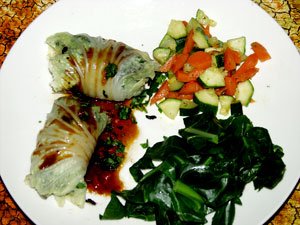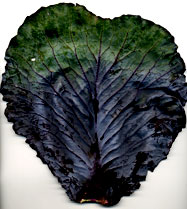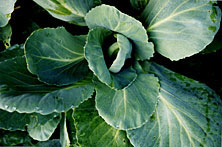What to Do With Those Leftovers?

I love making veggie burgers with leftover grains and/or legumes. Another delicious and nourishing way to eat those leftover grains is stuffed inside of a green leaf, cabbages being the most traditional way to prepare, but you could use a collard leaf or kale just as easily, or a large lettuce leaf, if it is summer when you make this dish.
Pictured here, the stuffed leaves are filled with a mixture of forbidden rice, chopped carrots, parsley & dandelion leaves with some tofu wrapped inside of Napa Cabbage Leaves. One day I made them adding in bits of steamed wild salmon, for more protein. You can make a simple sauce of tamari or umeboshi diluted and then thickened with arrowroot or kudzu for an even more nourishing and digestible meal. Below, you will also find suggestions for more kinds of easy sauces and vegetable accompaniments for a completely satisfying and delicious, nutritious meal.
The main trick with this dish, is to have everything ready for stuffing, then assemble and voila! You can make this ahead of time or when all of your ingredients are hot and just freshly made. You can use cold leftover rice & fillings then reheat in a medium oven, making sure to put in some vegetable stock on the bottom of the dish where you have layered your stuffed cabbages in a single layer, then cook till heated through from 20-40 minutes, depending on how fat you make your little cabbage packages. Also, if you make them too fat, the fillings will tend to spill out of their cabbage wrappers.
 First, separate your green leaves off of the head and if you're using kale, collards or standard green cabbage, cut out the thickest part of the ribs and put aside. (Some people add these to their vegetable stockpot, but I don't care for cruciferous vegetables in my stock unless I am making a cabbage soup.) Then wash a dozen leaves, figuring on 3 or 4 packages per person. Steam the leaves very lightly, so that they are just pliant enough to work with them. Then, take your preprepared fillings and place a heaping tablespoon or more into the center of the leaf. You want to leave enough room to wrap all sides of the leaf over the filling, overlapping most or all of the leaves, so that the filling is secure inside. If you like, you can use a toothpick, or small bamboo skewer, to secure the leaf & filling closed.
First, separate your green leaves off of the head and if you're using kale, collards or standard green cabbage, cut out the thickest part of the ribs and put aside. (Some people add these to their vegetable stockpot, but I don't care for cruciferous vegetables in my stock unless I am making a cabbage soup.) Then wash a dozen leaves, figuring on 3 or 4 packages per person. Steam the leaves very lightly, so that they are just pliant enough to work with them. Then, take your preprepared fillings and place a heaping tablespoon or more into the center of the leaf. You want to leave enough room to wrap all sides of the leaf over the filling, overlapping most or all of the leaves, so that the filling is secure inside. If you like, you can use a toothpick, or small bamboo skewer, to secure the leaf & filling closed.
Here's how to wrap:
After the filling is placed in the center, take the longest side and pull it completely over the filling, then take a short side, next to the one you just folded, (not the one directly across) and fold it in, then the side directly across from that one, then the last side, which should be directly across from the first side you folded in, and fold that on top of the other three folds. You can also make theses using three folds, if it is more conducive to the shape of your leaf.
Then place the folded sides on the bottom placed into your pan so that the unfolded side is facing up. Remember, if you are reheating this later, make sure you have a thin layer of water, or stock on the bottom of the oven proof pan, cover it, and then bake until warmed through. Serve with a sauce, or more stock, and chopped veggies and steamed greens on the side, for a fabulous, fiber filled, delicious vitamin rich meal!
Filling suggestions:
 Use any of the following ingredients that are available and local in the season in which you prepare this dish, remembering that less is more. Like the veggie burgers, you want the flavors of the ingredients to shine through and not blend into a chaotic mélange of competing tastes.
Use any of the following ingredients that are available and local in the season in which you prepare this dish, remembering that less is more. Like the veggie burgers, you want the flavors of the ingredients to shine through and not blend into a chaotic mélange of competing tastes.
Add sautéed or steamed & chopped: carrots, onions, celery, fennel, burdock, winter squash or summer squash, corn, string beans, peas, mushrooms, water chestnuts, chestnuts, turnips or daikon, seaweeds, spinach, other chopped and steamed leafy greens.
You can mix the above with any of the following: mashed cooked potatoes, sweet potatoes, winter squash, brown rice, lentils or any other cooked legumes, tofu chunks or tempeh or seitan, you could even use leftover cooked oatmeal or other breakfast porridge. You could add bits of cooked fish, seafood, meats or chicken if you eat those things. Again, try and limit your selections to about four or five ingredients only.
Sauce suggestions:
Try using mushrooms as the base for a sauce, as they add a lot of flavor and nourishment. You can make a sauce by using chopped up onion, celery, parsley & carrots, sautéed or steamed in stock or water. You can also add some grated ginger to the liquid. Or you can lightly roast fennel, cumin, celery or lovage seeds in the sauté pan, then add boiling water or stock to cover by 1 or 2 inches, a dash of tamari or soy sauce and then thicken.* Or you can omit the thickener, and simply cook this sauce and add a tablespoon of miso paste at the end, just before serving and spooning over the cabbages at table.
(*Grind up a tablespoon or two of kudzu root (available in health food stores) then add a tablespoon or two of cold water, and blend thoroughly. Then add this mixture to your slowly boiling sauce or stock, and whisk it in, or use a fork and beat it thoroughly so you don't get lumps. You can also use non gmo corn starch or arrowroot, in place of the kudzu.)
Try using a nut butter such as almond or sesame paste, taking a tablespoon and diluting with water, adding a dash of umeboshi vinegar or soy or tamari sauce, a dash of grated ginger and drizzling that over the cabbages. Or you can grind up a handful of whole nuts such as cashew, walnut or almonds, grinding into a paste, adding in stock or milk or soymilk, and seasoning with salt and pepper for a very rich taste treat.
Or just lightly toast the spices mentioned above, such as fennel seed, until fragrant, grind in a mortar and pestle, add a good quality cold pressed extra virgin olive oil, organic if you can find it, and drizzle the oil mixed with the spices over the cabbage packs.
Or get some good quality toasted sesame oil, and drizzle that over them.
Some nutrition background:  For a great overall look at the history and nutritional makeup of the cabbage family, check out this article at the vegetarian website Vegetarians in Paradise. They provide some historical and basic vegetarian nutritional information at their site.
For a great overall look at the history and nutritional makeup of the cabbage family, check out this article at the vegetarian website Vegetarians in Paradise. They provide some historical and basic vegetarian nutritional information at their site.
Cabbages, a member of the cruciferous family of vegetables, so called because of the cross shape of that plant family's four petaled yellow flowers have been the subject of many scientific studies, illuminating their cancer preventing properties. Cabbages have been used for centuries to cure many ailments from ulcers to scurvy. Sauerkraut was taken on long sea voyages to provide the antidote to scurvy.
Depending on the variety of cabbage used, they have both heating and cooling energetic properties (regular round heading and Chinese cabbage being more heating than the more cooling and moistening Napa and Savoy cabbages.) For those people with gaseous conditions, it is recommended to use some of the aforementioned digestive spices such as cumin, fennel and ginger to help aid in digesting this vegetable more easily.
According to Paul Pitchford in his encyclopedic work, "Healing With Whole Foods, Asian Traditions and Modern Nutrition", green and purple cabbages are slightly warming and moistening to the intestines and benefits the stomach, improves digestion and treats the common cold, frostbite and irritability among other abilities and also improves the skin. Many of it's healing properties come from sulfur, which is abundant in all the cruciferous vegetables (which include bok choi and other Asian chois, broccoli, brussel sprouts & cauliflower and all cabbages). The more cooling Napa cabbage is useful for inflammations, yellow mucus discharges and all other ailments that have heat symptoms, also moistening the intestines & treating constipation.**
Cabbage has been enjoyed since ancient times, both fresh and fermented, dried and smoked all around the world from Medieval Europe to ancient Norse cultures. It is presently enjoyed as pickled cabbage in Japan, as Kimchi in Korea, sauerkraut in eastern Europe (enjoying a renewed health status here in the US) or served as stuffed cabbage in Turkey and throughout eastern Europe, and is used in its many varieties in Chinese cooking. And let's not forget it's ubiquitous appearance in western summer fare, as cole slaw, perhaps an inheritance from the original Dutch settlers, who call cabbage 'kool' and salad 'sla'.
Try stuffed cabbage tonight for dinner! However, you enjoy cabbage, you will enjoy them in good health!!
** To find out more about Paul Pitchford, see his listing in our food section at Satya Center.
(All photos by Jane Sherry from the top are: Dinner with stuffed cabbages, mixed steamed carrots & zucchini, steamed collard greens; a red cabbage leaf, steaming forbidden rice just cooked, immature collard greens in the garden)
